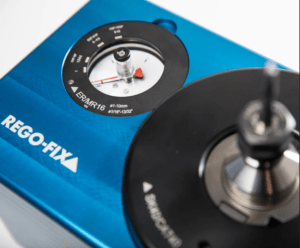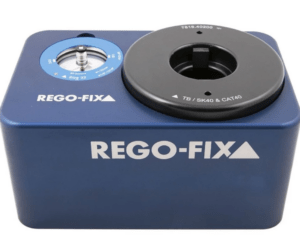If you think collet-based toolholder assembly and setup takes too much time and relies on methods more likely to cause problems than solve them, you’re not alone. To start, you look for the correct chart to find torque values based on holder series and tool diameter. Next, you locate the proper torque wrench, unlock it, set the torque level and re-lock it. Finally, you’re ready to tighten the collet nut or retention knob on the toolholder collet. Fortunately, newly developed TORCO-BLOCK tool setup technology offers a better way to set up your tools.
This new system eliminates the problems that often occur when shops use outdated, completely manual processes. Those processes become so complex that they cause confusion, and that’s an immediate prescription for poor results. Human error, especially with less-experienced operators, can damage toolholders and cause out-of-spec parts. Those outcomes cost shops time, money and even customers, none of which they can afford to lose, especially in the face of ever-increasing competition and strict part specifications.

Along with tighter tolerances, shops also face the “haste makes waste” challenges of quick turnarounds/short delivery times. In tool-setup desperation, some shops simply lock their torque wrenches at maximum values and never reset them, hoping to cut corners and be right at least part of the time. But some collet nuts transfer more force to a collet than others, or do so more efficiently, which means that a one-setting-fits-all approach fails more often than it succeeds. Incorrectly maxed-out torque settings yield over-tightened tools and transmit damaging force to the parts of toolholders least able to handle it. Along with compromised toolholders, collets and nuts, improper adjustment causes runout, which leads to poor surface finishes and scrapped parts.
To avoid over torquing, some well-meaning operators try to back off their settings and leave their torque wrenches on the loose side. Doing so is as detrimental as the opposite approach because instead of being too tight, the tools become loose enough to risk pulling out of the toolholders, creating danger for operators and damage to equipment.

At REGO-FIX, we’ve seen the negative impact of both these traditional tactics – and the costly, avoidable consequences on tools, toolholders and workpieces. In response, we evaluated this problem and created an elegantly simple solution, one that would assure that every assembly and setup operation produced properly torqued toolholders. The result is our simple, cost-effective TORCO-BLOCK system.
The TORCO-BLOCK tool-setup assistant allows shops to use any wrench to tighten their toolholders. The system accommodates all brands of collets with compatible torque ratings and all standard spindle interfaces, including ER, CAT, SK, BT, HSK and REGO-FIX CAPTO. The heart of the system is an analog device about the size of a shoebox – 10.629″ x 6.693″ and 5.118″ high (270 x 170 x 130 mm) – that mounts to a workbench using six bolts.
Color-coded indicator rings display the shank diameters for individual types of collets. Shops simply click the appropriate ring into place on top of the TORCO-BLOCK device, fasten the toolholder adapter with two screws, set one indicator to the correct shank diameter and tighten the toolholder. Inside the device, a hydraulic system measures torque and displays it on a pressure gauge next to the indicator ring. Once the system’s indicator needle lines up with the torque value, the setup is complete and correct.
In addition to working with REGO-FIX ER collets and toolholders, which dominate the 3Cs (computers, communications and consumer electronics), automotive and machine tool industries, TORCO-BLOCK also accommodates the REGO-FIX micRun toolholding system, the choice of many in the medical and watchmaking industries. Regardless of the size of your tools, consistently correct assembly torque enables them to perform as they should, last longer and yield precise workpiece results. The TORCO-BLOCK tool assembly system makes that adjustment easy and simple time after time.